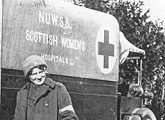Coughs and Sneezes
Influenza epidemics and public health
Influenza is in a highly contagious disease which may be caused by one of a whole family of viruses. A flu virus is spread through coughs and sneezes, and by contact with surfaces where the droplets thrown out by coughs and sneezes have settled. A flu vaccine grants temporary immunity from one particular variety of flu, but does not provide protection from the others. Washing your hands will reduce the chance of infection, and using a handkerchief will reduce the chance of spreading the virus to others.
Outbreaks of flu often develop into serious epidemics. Three times in the twentieth century this became pandemic, or worldwide. The most serious epidemic in history was the influenza pandemic at the end of the First World War. Below, Robert Brown of the Wellcome Trust Centre for the History of Medicine at University College, London writes about how the wealth of archival material in the Liddle Collection, Leeds University Library, can help our understanding of the Spanish Flu.
 .
. .
. .
. .
. .
.
Embroidered handkerchiefs, First World War. These are links to larger
images. Photos courtesy Liddle Collection, Leeds University Library.
The Liddle Collection
The richest source of archival material relating to the 1918 influenza pandemic in Britain is the Liddle Collection, Brotherton Library, Leeds University. The Liddle Collection is a vast resource of contemporary accounts of the First World War, from diaries and correspondence, to photos, audio recordings and personal memorabilia (badges, souvenirs, etc .). It is the best university archive for WWI related material, and its personal history holdings rivals that of larger, government-run facilities like the Imperial War Museum.
The 1918 influenza material in the Liddle Collection is abundant, but slightly inconspicuous (despite an excellent catalogue system and a very helpful staff). Substantial digging will reveal that the "forgotten pandemic," as many researchers have labelled the 1918 outbreak, was, in reality, the subject of much discussion during the First World War's final and decisive year. As it is a military archive, most of the Brotherton's influenza material relates directly to some aspect of the First World War and is to be found within soldier's diaries and letters.
For additional personal accounts of the 1918 pandemic within Britain and its armed forces, the Imperial War Museum is the best resource in the southern UK. The topic can also be explored in official sources (reports, unit war diaries, cabinet papers etc.) in the War Office, Ministry of Health, Ministry of Munitions and Admiralty files of the National Archives (formerly the Public Records Office).
The Spanish Flu
For insight into the pandemic's impact within Britain and its influence on the British war effort, the Liddle Collection's "General Aspects, Health and Fitness" (item #11), as well as the General Service and the Domestic Front files of Justice and Maxfield can be consulted. For the disease's effect on military operations abroad, Maclean is a good reference for those interested in the Macedonian front. The role of influenza during the battles for Italy can be explored in Bradley, Brooks, Cresswell and Ramshaw. For the Western Front: Clifton, Ferguson, Lamb, Mortimer, Murray, and Thompson. For information pertaining to the pandemic in the Royal Navy, the following items from the RNMN series are useful: Abercrombie, Corry, Gover, Mulligan, Stapleton and Wallis. For the Royal Air Force's outbreak: Cabeldu , Caton, Langdon, Pryce, and Simkins. Influenza references will also be encountered in: Ansell, Barley, Calnan, Dainty, Dumbreck, Eggleton, Escritt, Forester, Hutchings, Law, MacKay, Mead and West.
- Robert Brown, Wellcome Trust Centre for the History of Medicine at University College, London
You can receive regular updates on our special features by joining our mailing list.





